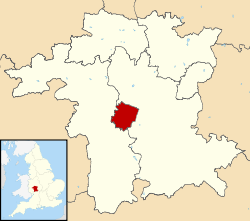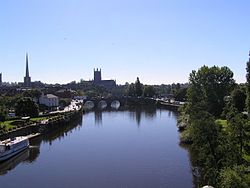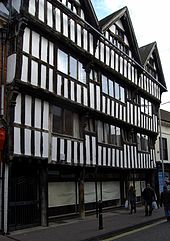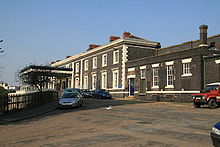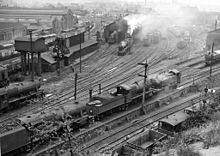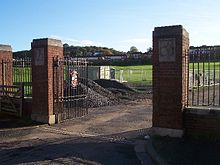- Worcester
-
This article is about the city in England. For the city in Massachusetts, see Worcester, Massachusetts. For other uses, see Worcester (disambiguation).
City of Worcester — City & Non-metropolitan district — 
Coat of armsCity of Worcester shown within Worcestershire Coordinates: 52°11′28″N 2°13′20″W / 52.19123°N 2.22231°W Sovereign state United Kingdom Constituent country England Region West Midlands Non-metropolitan county Worcestershire Status Non-metropolitan district, City Admin HQ Worcester Incorporated Government – Type Non-metropolitan district council – Borough council Worcester City Council (Conservative) – Mayor Dr. David Tibbutt – MPs Robin Walker (Conservative) Area – Total 12.8 sq mi (33.28 km2) Area rank 305th (of 326) Population (2010 est.) – Total 94,800 – Rank 237th (of 326) – Density 7,377.7/sq mi (2,848.6/km2) Time zone GMT (UTC0) – Summer (DST) BST (UTC+1) Postcodes WR1-5 Area code(s) 01905 ONS code 47UE OS grid reference SO849548 Website worcester.gov.uk The City of Worcester, commonly known as Worcester, (
 i/ˈwʊstər/ wuus-tər), is a city and county town of Worcestershire in the West Midlands of England. Worcester is situated some 30 miles (48 km) southwest of Birmingham and 29 miles (47 km) north of Gloucester, and has an approximate population of 94,000 people. The River Severn runs through the middle of the city, overlooked by the twelfth-century Worcester Cathedral. The site of the final battle of the Civil War, Worcester was where Oliver Cromwell's New Model Army defeated King Charles II's Cavaliers, resulting in the English Interregnum, the ten year period during which England and Wales became a republic. Worcester was the home of Royal Worcester Porcelain and the birthplace of the composer Sir Edward Elgar. It houses the Lea and Perrins factory where the traditional Worcestershire Sauce is made, and is home to one of the UK's fastest growing Universities, The University of Worcester, which has a growing academic reputation.
i/ˈwʊstər/ wuus-tər), is a city and county town of Worcestershire in the West Midlands of England. Worcester is situated some 30 miles (48 km) southwest of Birmingham and 29 miles (47 km) north of Gloucester, and has an approximate population of 94,000 people. The River Severn runs through the middle of the city, overlooked by the twelfth-century Worcester Cathedral. The site of the final battle of the Civil War, Worcester was where Oliver Cromwell's New Model Army defeated King Charles II's Cavaliers, resulting in the English Interregnum, the ten year period during which England and Wales became a republic. Worcester was the home of Royal Worcester Porcelain and the birthplace of the composer Sir Edward Elgar. It houses the Lea and Perrins factory where the traditional Worcestershire Sauce is made, and is home to one of the UK's fastest growing Universities, The University of Worcester, which has a growing academic reputation.Contents
History
Occupation of the site of Worcester can be dated back to Neolithic times, a village surrounded by defensive ramparts having been founded on the eastern bank of the River Severn here in around 400 BC. The position, which commanded a ford on the river, was in the first century used by the Romans to establish what may at first have been a fort on the military route from Glevum (Gloucester) to Viroconium (Wroxeter) but which soon developed – as the frontier of the empire was pushed westwards – into an industrial town with its own pottery kilns and iron-smelting plants.
Roman Worcester (which may have been the Vertis mentioned in the seventh century Ravenna Cosmography) was a thriving trading and manufacturing centre for some three hundred years, though by the time of the Roman withdrawal from Britain in 407 it had dwindled considerably in size and is not recorded again until the mid-seventh century when documents mention the Anglo-Saxon settlement Weorgoran ceaster (settlement of the people by the winding river).[1] The fact that Worcester was chosen at this time – in preference to both the much larger Gloucester and the royal centre of Winchcombe – to be the Episcopal See of a new diocese covering the area suggests that there may have been a well established, and powerful, Christian community living on the site when it fell into English hands.
The town was almost destroyed in 1041 after a rebellion against the punitive taxation of Harthacanute. The town was attacked several times (in 1139, 1150 and 1151) during "The Anarchy", i.e. civil war between King Stephen and Empress Matilda, daughter of Henry I. This is the background to the well-researched historical novel The Virgin in the Ice, part of Ellis Peters' "Cadfael" series, which begins with the words:
"It was early in November of 1139 that the tide of civil war, lately so sluggish and inactive, rose suddenly to wash over the city of Worcester, wash away half of its lifestock, property and women, and send all those of its inhabitants who could get away in time scurrying for their lives northwards away from the marauders". (These are mentioned as having arrived from Gloucester, leaving a long lasting legacy of bitterness between the two cities.)
By late medieval times the population had grown to around 10,000 as the manufacture of cloth started to become a large local industry. The town was designated a county corporate, giving it autonomy from local government.
Worcester was the site of the Battle of Worcester (3 September 1651), when Charles II's attempt to regain the crown by force was decisively defeated, in the fields a little to the west and south of the city, near the village of Powick. After being defeated, Charles returned to his headquarters in what is now known as King Charles house in the Cornmarket, before fleeing in disguise to Boscobel House in Shropshire and his eventual escape to France. Worcester was one of the cities loyal to the King in that war, for which it was given the epithet "Fidelis Civitas" ("The Faithful City"). This motto has been incorporated into the city's coat of arms.[2]
In 1670, the River Severn broke its banks and the subsequent flood was the worst ever seen by Worcester. A brass plate can be found on a wall on the path to the cathedral by the path along the river showing how high this flood went, and other flood heights of more recent times are also shown in stone bricks. The closest flood height to what is known as The Flood of 1670 was when the Severn flooded in the torrential rains of July 2007.
The Royal Worcester Porcelain Company factory was founded by Dr John Wall in 1751, although it no longer produces goods. A handful of decorators are still employed at the factory and the Museum is still open.
During the late eighteenth and early nineteenth centuries, Worcester was a major centre for glove making, employing nearly half the glovers in England at its peak (over 30,000 people).[3] In 1815 the Worcester and Birmingham Canal opened, allowing Worcester goods to be transported to a larger conurbation.
The British Medical Association (BMA) was founded in the Board Room of the old Worcester Royal Infirmary building in Castle Street in 1832.[4] While most of the Royal Infirmary has now been demolished to make way for the University of Worcester's new city campus, the original Georgian building has been preserved.[5] There are plans to reopen the building as a medical museum.[6]
During World War II, the city was chosen to be the seat of an evacuated government in case of mass German invasion. The War Cabinet, along with Winston Churchill and some 16.000 state workers, would have moved to Hindlip Hall (now part of the complex forming the Headquarters of West Mercia Police), 3 miles (4.8 km) north of Worcester, and Parliament would have temporarily seated in Stratford-upon-Avon.
In the 1950s and 1960s large areas of the medieval centre of Worcester were demolished and rebuilt as a result of decisions by town planners. There is still a significant area of medieval Worcester remaining, but it is a small fraction of what was present before the redevelopments.
The current city boundaries date from 1974, when the Local Government Act 1972 transferred the parishes of Warndon and St. Peter the Great County into the city.
Governance
The Conservatives had a majority on the council from 2003 to 2007, when they lost a by-election to Labour meaning the council had no overall control.[7] The Conservatives remained with the most seats overall with 17 out of 35 seats after the 2008 election.[8] Worcester has one member of Parliament, Robin Walker of the Conservative Party, who represents the Worcester constituency as of the May 2010 general election.[9]
The County of Worcestershire's local government arrangement is formed of a non-metropolitan county (Worcestershire County Council) and six non-metropolitan districts, with Worcester City Council being the district for most of Worcester, with a small area of the St. Peters suburb actually falling within neighbouring Wychavon District. The Worcester City Council area includes two parish councils, these being Warndon Parish Council and St Peter the Great Parish Council.
Geography
Notable suburbs in Worcester include Barbourne, Claines, Northwick, St Peter the Great (also simply known as St Peters), Red Hill, Ronkswood, Tolladine, Blackpole, Warndon and Warndon Villages (which was once the largest housing development in the Country when the area was being constructed in the late 1980s/very early 1990s). Most of Worcester is on the eastern side of the River Severn; Henwick, Lower Wick Diglis, Cherry Orchard and St. John's are on the western side.
Climate
Climate data for Worcester Month Jan Feb Mar Apr May Jun Jul Aug Sep Oct Nov Dec Year Average high °C (°F) 8
(46)9
(48)11
(52)14
(57)18
(64)20
(68)23
(73)23
(73)19
(66)15
(59)11
(52)7
(45)15 Average low °C (°F) 3
(37)4
(39)4
(39)6
(43)8
(46)12
(54)13
(55)13
(55)11
(52)8
(46)6
(43)4
(39)8 Precipitation mm (inches) 63.2
(2.488)51.2
(2.016)46.5
(1.831)77.7
(3.059)45.9
(1.807)52.3
(2.059)43.3
(1.705)53.9
(2.122)63.4
(2.496)93.3
(3.673)69.5
(2.736)77.8
(3.063)738
(29.06)Source: [10] Demography and religion
The 2001 census[11] recorded Worcester's population at 93,353. About 96.5% of Worcester's population was white; of which 94.2% were White British,[12] greater than the national average.[13] The largest religious group are Christians, who made up 77% of the city's population.[14] People who reported having no religion or who did not state their religion made up 21% of the city's population. Other religions totaled less than 2% of the population. Ethnic minorities include people of Chinese, Indian, Pakistani, Italian and Polish origin, with the largest single minority group being British Pakistanis, numbering around 1,200, approximately 1.3% of Worcester's population.[14] This has led to Worcester containing a small but diverse range of religious groups; as well as the commanding Worcester Cathedral (Church of England), there are also Catholic and Baptist churches, a large centre for The Church of Jesus Christ of Latter-day Saints (Mormons), an Islamic mosque, and a number of smaller interest groups regarding Eastern Religions such as Buddhism and the Hare Krishnas.[15]
Worcester is the seat of a Church of England bishop. His official signature is his Christian name followed by Wigorn, which is also occasionally used as an abbreviation for the name of the county.
Economy
Industry is now quite varied. In the nineteenth and early twentieth century, Worcester was a major centre for glove manufacture, but this has declined greatly. The late-Victorian period saw the growth of ironfounders, like Heenan & Froude, Hardy & Padmore and McKenzie & Holland.
Manufacturing
The inter-war years saw the rapid growth of engineering, producing machine tools James Archdale, H.W. Ward, castings for the motor industry Worcester Windshields and Casements, mining machinery Mining Engineering Company (MECO) which later became part of Joy Mining Machinery and open-top cans Williamsons, though G H Williamson and Sons had become part of the Metal Box Co in 1930. Later the company became Carnaud Metal Box PLC.
Worcester Porcelain operated in Worcester until 2008 when the factory was closed down due to the recession. However, the site of Worcester Porcelain still houses the Worcester Porcelain Museum which is open daily to visitors.[16]
One of Worcester's most famous products, Lea & Perrins Worcestershire sauce is made and bottled in the Midland Road factory in Worcester, which has been the home of Lea & Perrins since 16 October 1897. Mr Lea and Mr Perrins originally met in a chemist's shop on the site of the now Debenhams store in the Crowngate Shopping Centre.
The surprising foundry heritage of the city is represented by Morganite Crucible[17] at Norton which produces graphitic shaped products and cements for use in the modern industry.
The Kays[18] mail order business was founded in Worcester in the 1880s and operated from numerous premises in the city[19] until 2007. It was then bought out by Reality, owner of the Grattan catalogue. Kays' former warehouse building was knocked down in 2008. Worcester is the home of what is claimed to be the oldest newspaper in the world, Berrow's Worcester Journal, which traces its descent from a news-sheet that started publication in 1690. The city is also a major retail centre with several covered shopping centres that has most major chains represented as well as a host of independent shops and restaurants, particularly in Friar Street and New Street.
Retail trade
Worcester’s main shopping centre is the High Street, home to the stores of major retail chains such as Marks & Spencer, Pandora (jewelry), House of Fraser, TK Maxx, Primark, Next, and Debenhams. Part of the High Street was modernised in 2005 amid much controversy, many comments were reported in the Worcester News. Many of the issues focussing on the felling of long-standing trees, the duration of the works (caused by the weather and an archaeological find) and the removal of flagstones outside the city’s eighteenth century Guildhall. The other main thoroughfares are The Shambles and Broad Street, while The Cross (and its immediate surrounding area) is the city’s financial centre and location of the majority of Worcester’s main bank branches.
There are three main covered shopping centres in the City Centre, the CrownGate Shopping Centre, Cathedral Plaza and Reindeer Court. There are three retail parks, the Elgar and Blackpole Retail Parks, which are located in the Blackpole area of the city, and the Shrub Hill Retail Park which is located immediately outside the city centre.
Landmarks
Probably the most famous landmark in Worcester is its imposing Worcester Cathedral. The current building, formally named The Cathedral Church of Christ and the Blessed Virgin Mary, was begun in 1084 while its crypt dates from the tenth century. The chapter house is the only circular one in the country while the cathedral also has the distinction of having the tomb of King John. Limited parts of the city wall still remain.
There are three main parks in Worcester, Cripplegate Park, Gheluvelt Park and Fort Royal Park, the latter being on one of the battles sites of the English Civil War. In addition, there is a large open area known as Pitchcroft to the North of the city centre on the east bank of the River Severn, which, apart from those days when it is being used for horse racing, is a public space.
Gheluvelt Park was opened as a memorial to commemorate the Worcestershire Regiment's 2nd Battalion after their part in the Battle of Gheluvelt, during World War I.
There are also two large woodlands in the city, Perry Wood, at twelve hectares, and Nunnery Wood, covering twenty-one hectares. Perry Wood is often said to be the place where Oliver Cromwell met and made a pact with the devil.[20] Nunnery Wood is an integral part of the adjacent and popular Worcester Woods Country Park, itself next door to County Hall on the east side of the city.
Destinations from Worcester

Tenbury Wells, Ludlow Droitwich, Kidderminster, Dudley, Wolverhampton Bromsgrove, Redditch, Birmingham 
Leominster, Bromyard 
Stratford-upon-Avon, Warwick  Worcester
Worcester 

Hereford, Malvern Upton-Upon-Severn, Gloucester, Cheltenham, Bristol Banbury, Pershore, Evesham, Oxford Transport
Road
The M5 Motorway runs north-south immediately to the east of the City, and is accessed by Junction 6 (Worcester North) and Junction 7 (Worcester South). This makes the city easily accessible by car to most parts of the country, including London which is only 120 miles (190 km) away (via the M5, M42 and M40).
Several A roads pass through the city. The A449 road runs south-west to Malvern and north to Kidderminster. The A44 runs south-east to Evesham and west to Leominster and Aberystwyth and crosses Worcester Bridge. The A38 trunk road runs south to Tewkesbury and Gloucester and north-north-east to Droitwich and Birmingham. The A4103 goes west-south-west to Hereford. The A422 heads east to Alcester, branching from the A44 a mile east of the M5. The city is encompassed by a partial ring road (A4440) which is formed, rather inconsistently, by single and dual carriageways. The A4440 road provides a second road bridge across the Severn (Carrington Bridge) just west of the A4440-A38 junction. Carrington Bridge links the A38 from Worcester towards Gloucester with the A449 linking Worcester with Malvern.
Rail
Worcester has two stations, Worcester Foregate Street and Worcester Shrub Hill.
Worcester Foregate Street is located in the city centre, on Foregate Street. Although featuring two tracks Foregate Street consists of two bi-directional single working lines, one of which is the Birmingham to Worcester line while the other is the Cotswold Line, which Shrub Hill also serves.
Worcester Shrub Hill is located just outside the city centre on Shrub Hill Road. The station is on the Cotswold Line as well being a spur off the Birmingham to Worcester line. Unlike Foregate Street, Shrub Hill does not have single working lines. Being the much bigger of Worcester's stations, due to a large number of tracks and sidings, Shrub Hill is often used as a stabling point and a through route for freight trains.
Both stations frequently serve Birmingham and nearby towns and cities, with services primarily provided by London Midland, while London is also served frequently by both stations via the Cotswold Line and, infrequently, via the Birmingham-Bristol/Gloucester-Swindon/Bristol-London lines. Train services to London are operated by First Great Western.
Although connected to the Birmingham-Bristol 'Cross Country' mainline only two miles away, Worcester is not served by Inter City Cross Country services therefore making Worcestershire the only county in England where Inter City Cross Country services pass through but do not stop in during normal scheduled timetables. The proposed station, Worcestershire Parkway is expected to end this.[citation needed]
Bus
The main operator of bus services in and around the city is First Midlands, while Diamond Bus Company, trading as Red Diamond, and Worcestershire County Council, trading as Woosh, operate many other services. A few other smaller operators provide services in Worcester, most notably Astons (Veolia Transport) and Bromyard Omnibus Company. The terminus and interchange for many bus services in Worcester is Crowngate Bus Station located in the city centre.
See also: List of bus routes in Worcestershire and Worcestershire bus route 144Park and ride
There are two park and ride sites serving Worcester, one located off the A38 in the Perdiswell area of the city and the other located at Worcester Rugby Football Club's Sixways Stadium next to junction 6 of the M5 motorway.
Perdiswell site
A direct and limited stop bus service (W1), operated by Worcestershire County Council under the Woosh name, runs every ten minutes between the Perdiswell site and the cityity centre and vice versa, between 7am and 6:45pm Monday to Saturday.
The stops on the W1 service are at: • Perdiswell Park & Ride • St Stephen’s Church (Barbourne area) • St George’s Square (Barbourne area) • Little London for Royal Grammar School (Barbourne area) • Foregate Street Rail Station (city centre) • Worcester Bus Station (city centre)
Sixways Stadium site
Two circular bus services (W2 and W3), operated by Worcestershire County Council under the Woosh name, link the Sixways site to the Worcestershire Royal Hospital and the government offices on Whittington Road, Monday to Friday.
Air
Worcester's nearest major airport is Birmingham International approximately 45 minutes by road via the M5 and M42 motorways.
Education
Worcester is home to the University of Worcester, which was awarded university status in 2005 by HM Privy Council. From 1997 to 2005 it was known as University College Worcester (UCW) and prior to 1997 it was known as Worcester College of Higher Education. From 2005 to 2010 it was the fastest growing university in the UK, more than doubling its student population. The University is also home to the independent Worcester Students Union institution. The city is also home to two colleges, Worcester Sixth Form College and Worcester College of Technology.
High schools
The High schools located in the city are Bishop Perowne CofE College, Blessed Edward Oldcorne Catholic College, Christopher Whitehead Language College, Tudor Grange Academy Worcester (on the site of the defunct Elgar High School), Nunnery Wood High School and New College Worcester which caters for blind and partially sighted students from the ages of 11 to 18.
Independent schools
Worcester is also the seat of three independent schools. The Royal Grammar School, founded in 1291, and Alice Ottley School merged in 2007. The King's School, Worcester was re-founded in 1541 under King Henry VIII. Saint Mary's Convent School, now the only all-girls school in the city, is the third private school in the city. Other independent schools include the Independent Christian school, the River School in Fernhill Heath.
Sport
- Worcester Warriors, an Aviva Premiership Rugby Union team who play at Sixways Stadium.
- Worcestershire County Cricket Club whose home ground is New Road.
- Blue Square Conference South side Worcester City F.C. who play at St George's Lane.
- Worcester St Johns Cycling Club
- Worcester Wolves, a professional basketball team in the British Basketball League.
- Worcester Racecourse is on an open area known as "Pitchcroft" on the east bank of the River Severn.
- Worcester has King George's Field in memorial to King George V.
- Worcester Rowing Club which is situated near the city centre on the River Severn.
- University of Worcester Rowing Club which shares accommodation with Worcester Rowing Club.
- University of Birmingham Rowing Club
- Worcester Athletics Club who meet on Tuesdays and Thursdays at Nunnery Wood Sports Centre
- Worcester University Climbing and Mountaineering Club
Culture
Festivals and shows
Every three years Worcester becomes home to the Three Choirs Festival, which dates from the eighteenth century and is credited with being the oldest music festival in Europe. The location of the festival rotates each year between the Cathedral Cities of the Three Counties, Gloucester, Hereford and Worcester. Famous for its championing of English music, especially that of Elgar, Vaughan Williams and Gustav Holst, Worcester last hosted the festival in August 2011.
The Worcester Festival is a relatively new venture established in 2003. Held in late August, the festival consists of a variety of music, theatre, cinema and workshops, as well as the already established Beer Festival, which runs as an event within the Worcester Festival.
For one weekend the city plays host to the Worcester Music Festival. Now in its 4th year (2011) the festival comprises a weekend original music by predominantly local bands and musicians. All performances are free, and take place throughout the city centre in bars, clubs, community buildings, churches and the library. In 2010 the festival comprised 230 unique acts.
Worcester Festival ends with a spectacular firework display on the banks of the River Severn on the Monday of the August bank holiday.
The Victorian-themed Christmas Fayre is a major source of tourism every December. Elton John came to the Worcestershire Cricket Ground, New Road on Saturday 9 June 2006. Status Quo came to Sixways Stadium (Worcester Warriors) on Saturday 28 July 2007.
The twelfth CAMRA Worcester Beer and Cider festival took place for three days from the 17 August 2010[21] and was held as usual on Pitchcroft Race Course.
The Worcester Beer, Cider and Perry festival is the largest beer festival within the West Midlands with the 2009 event being attended by 11,000 people.
Arts and cinema
Famous eighteenth century actress Sarah Siddons made her acting début here at the Theatre Royal in Angel Street. Her sister, the novelist Ann Julia Kemble Hatton,[22] otherwise known as Ann of Swansea, was born in the city. Matilda Alice Powles, better known as Vesta Tilley, a leading male impersonator and music hall artiste was born in Worcester.
In present-day Worcester the Swan Theatre[23] stages a mixture of professional touring and local amateur productions. The Countess of Huntingdon's Hall[23] is a historic church now used as venue for an eclectic range of musical performances, while the Marrs Bar[24] is a venue for gigs and stand-up comedy. Worcester has two multi-screen cinemas; a Vue Cinema complex located on Friar Street, and an Odeon Cinema on Foregate Street – both of which were 3D-equipped by March 2010.
In the northern suburb of Northwick is the Art Deco Northwick Cinema. Built in 1938 it contains one of the only two remaining interiors in Britain designed by John Alexander (the original perspective drawings are still held by RIBA). It was a Bingo Hall from 1966 to 1982 and then empty until 1991; it was then run as a music venue until 1996, and was empty again until Autumn 2006 when it became an antiques and lifestyle centre, owned by Grey's Interiors, who were previously located in The Tything.[citation needed]
There are a number of other arts organisations in Worcester. Based at the University and also Bishop Perowne Performing Arts College is C&T (formerly Collar & Tie), an educational theatre company that specialises in theatre for young people tackling topical issues using a blend of drama and new media technologies.[25]
Media
Worcester is home to Worcester News, Worcester Standard and Berrow's Worcester Journal newspapers and radio stations BBC Hereford & Worcester, Wyvern and Youthcomm Radio.
Twinning and planned twinning
Worcester is twinned with the German city of Kleve, the Parisian commune of Le Vésinet, and its larger American namesake Worcester, Massachusetts.[26]
In February 2009 Worcester City Council's Twinning Association began deliberating an application to twin Worcester with the Palestinian city of Gaza. Councillor Alan Amos introduced the application, which was passed at its first stage by a majority of 35-6.[27] The proposal was later rejected by the Executive Committee of the City of Worcester Twinning Association for lack of funding due to its present commitment to existing twinning projects.[28]
Notable people
- Composer Sir Edward Elgar's father ran a music shop at the end of the High Street; a statue of Elgar stands near the original location of that shop. His birthplace is a short way outside Worcester in the village of Broadheath.
- Hannah Snell, famous for impersonating a man and being enlisted in the Royal Marines in the eighteenth century was born and raised here.
- Sir Charles Hastings, founder of the British Medical Association lived in Worcester for most of his life. The newly built Worcestershire Royal Hospital stands in a road named in his honour.
- William Stephenson 2007 British streetluge and buttboard champion and 2009 world number three streetluger and number two buttboarder was born and lives in Worcester.
- Philip Henry Gosse, naturalist, was born in the city in 1810.
- Sir Thomas Brock, sculptor most famous for the Imperial Victoria Memorial in London was born here in 1847.
- Edward Leader Williams, designer of the Manchester Ship Canal, was born and raised in Worcester, living at Diglis House (now the Diglis House Hotel) with his brother, noted landscape artist Benjamin Williams Leader.
- William Morris, Lord Nuffield, (founder of the Morris Motor Company and philanthropist), spent the first three years of his life in the city.
- Geoffrey Anketell Studdert Kennedy, poet and author, famously known as "Woodbine Willy", was for some time the Vicar of St. Paul's Church in the city. He rose to fame during World War I when he became an army chaplain, his sermons and poetry helping boost morale to the troops. He acquired his nickname from his habit of handing out "Woodbine" cigarettes to the men in the trenches.
- Mrs. Henry Wood writer, was born in Worcester.
- Fay Weldon writer, was born in Worcester.
- Revd Thomas Davis, hymn-writer, was born in Worcester in 1804. He is an ancestor of The Duchess of Cambridge.
- Worcester was home to electronic music producer and collaborator Mike Paradinas and his record label Planet Mu, until the label moved to London in 2007.
- Dave Mason musician, singer, songwriter and guitarist, was born in Worcester.
- Andrew Hung and Benjamin John Power of experimental music group Fuck Buttons were both raised in Worcester.
- George Webb, better known to the population of Worcester as Chicken George became synonymous with Worcester for about half a century, dancing along to the music of street buskers, much to the amusement of the general public. No one knows how the nickname Chicken George came about but common rumour is that his erratic dancing reminded people of a pecking chicken. Chicken George was fiercely patriotic and claimed to have fought in the war at Dunkirk for the Worcestershire regiment. He was well known for his attendance at Remembrance Day parades at the cathedral and religiously attended regimental reunions.
- Ernest Payne was born in Worcester and rode for the local Worcester St Johns Cycling Club. He won a gold medal in the team pursuit at the 1908 Summer Olympics in London.
- Sheila Scott, aviatrix
- James White (1775–1820), founder of the first advertising agency in 1800 in London, was born in Worcester.
- Ann Hatton, writer of the Kemble family was born in Worcester.
- See also People from Worcester.
See also
- List of Bishops of Worcester
- Worcester Cathedral
- Worcester City Art Gallery & Museum
- Worcester Porcelain Museum
References
- ^ "Severn Past". Library.thinkquest.org. http://library.thinkquest.org/08aug/00976/Severn%20yesterday.html. Retrieved 27 September 2010.
- ^ "Civic Heralrdy of England and Wales – Worcestershire". civicheraldry.co.uk. http://www.civicheraldry.co.uk/worcs.html. Retrieved 22 January 2009.
- ^ "Worcester glove-making". BBC. http://www.bbc.co.uk/ahistoryoftheworld/objects/ftRyrzGHSdqjcFiBLdgwGA. Retrieved 18 January 2011.
- ^ "An outline history of the British Medical Association". British Medical Association. 11 September 2006. http://www.bma.org.uk/about_bma/BMAOutlineHistory.jsp. Retrieved 27 September 2010.
- ^ "University demolition work starts". BBC News. 3 January 2008. http://news.bbc.co.uk/2/hi/uk_news/england/hereford/worcs/7170810.stm. Retrieved 26 January 2010.
- ^ "History of Worcester Royal Infirmary to Be Brought Back to Life". University of Worcester. 5 November 2009. http://www.worc.ac.uk/about/news/12942.html. Retrieved 26 January 2010.
- ^ Beaten Tory Keeps A Low Profile (from Worcester News)
- ^ "Worcester". BBC News Online. 19 April 2008. http://news.bbc.co.uk/1/shared/bsp/hi/elections/local_council/08/html/47ue.stm. Retrieved 8 January 2010.
- ^ "Michael Foster: Electoral history and profile". London: guardian.co.uk. http://www.guardian.co.uk/politics/person/1788/michael-foster. Retrieved 8 January 2010.
- ^ "Averages for Worcester". http://weather.msn.com/monthly_averages.aspx?&wealocations=wc%3aUKXX0161&q=Worcester%2c+GBR&setunit=C.
- ^ "Census 2001 – Profiles – Worcester". Statistics.gov.uk. 13 February 2003. http://www.statistics.gov.uk/census2001/profiles/47ue.asp. Retrieved 27 September 2010.
- ^ "Worcester Town Profile". http://worcestershire.whub.org.uk/cms/pdf/Worcester_Town_Profile.pdf.
- ^ "National Statistics Online – Population Size". Statistics.gov.uk. 8 January 2004. http://www.statistics.gov.uk/cci/nugget.asp?id=455. Retrieved 27 September 2010.
- ^ a b "Census 2001 – Profiles – Worcester". Statistics.gov.uk. 13 February 2003. http://www.statistics.gov.uk/census2001/profiles/47ue.asp#ethnic. Retrieved 27 September 2010.
- ^ BBC Hereford & Worcester feature on the Hare Krishna movement (ISKCON)
- ^ "Worcester Porcelain Museum". Worcester Porcelain Museum. http://www.worcesterporcelainmuseum.org.uk. Retrieved 27 September 2010.
- ^ Morganite Crucible
- ^ http://www.kays.com kays.com/
- ^ Kays Heritage
- ^ Fraser, Antonia (1973). Cromwell Our Chief of Men. p. 387. ISBN 0-09-942756-7.
- ^ From camra.org.uk
- ^ Ann Julia Kemble Hatton
- ^ a b Worcsterlive Retrieved 27 September 2010
- ^ The Marrs Bar official site
- ^ "Bishope Perowne Performing Arts College". http://www.bishopperowne.co.uk/home. Retrieved 27 September 2010.
- ^ Lauren Rogers (31 January 2008). "City to fight US twin 'snub'". Worcester News. http://www.worcesternews.co.uk/search/2010387.City_to_fight_US_twin__snub_/.
- ^ Staff (26 February 2009). "Worcester could be twinned with Gaza City". Worcester News. http://www.worcesternews.co.uk/news/4155017.Worcester_could_be_twinned_with_Gaza_City/. Retrieved 27 February 2009.
- ^ Staff (10 March 2009). Worcester News. http://www.worcesternews.co.uk/search/4189742.Gaza_twinning___the_decision_is_in/. Retrieved 9 July 2009.
External links
Districts of the West Midlands Region Herefordshire 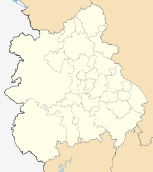
Shropshire Staffordshire Warwickshire West Midlands Birmingham · Coventry · Dudley · Sandwell · Solihull · Walsall · Wolverhampton
Worcestershire Bromsgrove · Malvern Hills · Redditch · Worcester · Wychavon · Wyre Forest
Cities of the United Kingdom England Bath · Birmingham · Bradford · Brighton and Hove · Bristol · Cambridge · Canterbury · Carlisle · Chester · Chichester · Coventry · Derby · Durham · Ely · Exeter · Gloucester · Hereford · Kingston upon Hull · Lancaster · Leeds · Leicester · Lichfield · Lincoln · Liverpool · London · Manchester · Newcastle upon Tyne · Norwich · Nottingham · Oxford · Peterborough · Plymouth · Portsmouth · Preston · Ripon · St Albans · Salford · Salisbury · Sheffield · Southampton · Stoke-on-Trent · Sunderland · Truro · Wakefield · Wells · Westminster · Winchester · Wolverhampton · Worcester · York
Scotland Wales Northern Ireland Categories:- Worcester
- Populated places on the River Severn
- County towns in England
- Local government in Worcestershire
- Non-metropolitan districts of Worcestershire
- Local government districts of the West Midlands (region)
Wikimedia Foundation. 2010.

